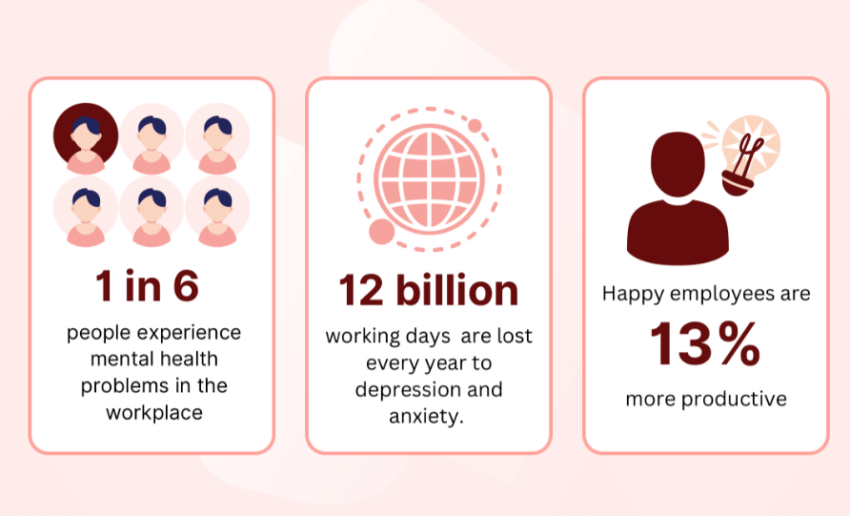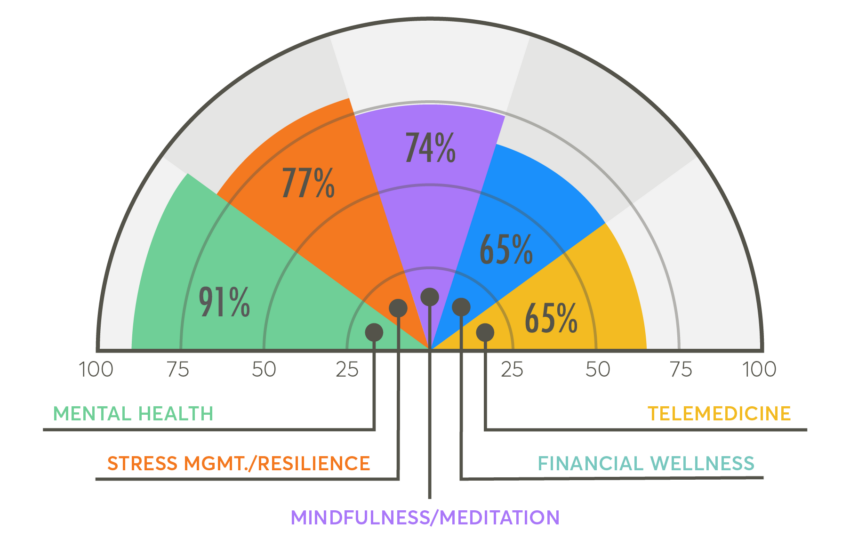Workplace wellness has never been more important. Heightened stress levels, burnout, and decreased productivity are prevalent issues across multiple industries. In today’s remote work environment, it is essential to prioritize employee well-being. Here are several ways to promote workplace wellness in a web3 environment.
In this guide:
- The influence of mental health on productivity
- Find your dream job
- Do you wanna learn the ins and outs of getting a job in the web3 world?
- Importance of workspace wellness in web3 teams
- Tips for promoting workplace wellness in web3
- Measuring the impact of workplace wellness initiatives
- Web3 and the future of workplace wellness
The influence of mental health on productivity

A study conducted by Spill shed some light on alarming numbers regarding workplace mental health statistics.
- Since the pandemic, 81% of workplaces have increased their focus on employee mental health.
- However, 1/3 of employees still feel that mental health support in their workplace is inadequate and would like more help from their employers.
- Nearly half (48%) employees say their mental well-being declined in 2022.
- Globally, around 12 billion working days — or 50 million years of work — are lost every year to depression and anxiety.
- Mental health issues cost the global economy around $1 trillion every year.
To top it all off, in August 2022, 4.15 million individuals resigned from their jobs, as reported by the U.S. Bureau of Labor Statistics. This figure is concerning as recruitment is time-consuming and can cost anywhere from half to twice the departing employee’s annual salary, according to Gallup.
Find your dream job
Do you wanna learn the ins and outs of getting a job in the web3 world?
Importance of workspace wellness in web3 teams
Also known as “corporate well-being,” the importance of holistic wellness in web3 teams goes beyond the traditional understanding of employee health. Corporate well-being in web3 extends beyond physical health – it covers mental resilience, social connection, and work-life balance. Web3 jobs mostly operate in a digital reality where traditional office structures give way to virtual collaborations and remote interactions.
Offering support and resources to uphold physical and mental well-being, fostering strong connections with coworkers, and helping individuals find purpose in their work becomes crucial. Each team member’s well-being directly influences the entire workforce’s collective health.

In 2023, employers will focus on mental health (91%), stress management (77%), mindfulness (74%), financial wellness (65%), and telemedicine (65%). Addressing mental health as a key concern, these benefits, especially the top three, are interrelated. Additionally, investment in telemedicine aims to improve healthcare access.
Tips for promoting workplace wellness in web3
To promote workplace wellness in a web3 setting, tailor approaches to the unique challenges of the decentralized crypto job world. Reconsider and reimagine traditional strategies in light of the nature of digital work.
Encouraging healthy work-life balance

When work spills into our personal areas, it obscures the distinction between job and private life, complicating the attainment of work-life balance. Consequently, this can result in frequent overworking, increased distractibility, exhaustion, a felt need for continual presence, and a decline in motivation.
Setting clear expectations for working hours is a foundational step. In a web3 remote job setting, where teams might be spread across different time zones, establishing transparent guidelines regarding when employees are expected to be available for synchronous collaboration helps create a sense of structure.
Promoting the use of designated breaks is another crucial aspect. In a traditional office, breaks may naturally occur during lunch hours or coffee breaks with colleagues. In a decentralized environment, where virtual spaces replace the physical office, encouraging team members to take regular breaks becomes essential for maintaining both physical and mental well-being in check. Whether it’s a brief walk, a mindfulness exercise, or simply stepping away from the screen, these breaks contribute to overall work-life balance.
Prioritizing employee mental health
Companies can nurture employee mental health by providing incentives, engaging in activities, and fostering a “culture of health.” The initial step involves destigmatizing mental health discussions by promoting open conversations and normalizing the importance of seeking help for future web3 candidates.
Companies fostering health culture should launch mental well-being initiatives. Initially, they can implement online counseling through virtual wellness programs. Additionally, establishing counseling hotlines is key. Organizing mental health workshops and webinars further enhances this strategy. Conducting well-being surveys is also vital for impact assessment. Finally, providing mindfulness and guided meditation sessions rounds out these efforts.
Additional activities include medical screenings, weight loss and stress management programs, smoking cessation support, and health club memberships. Also, offering gym passes, wellness competitions, and digital platforms expands these initiatives.
Companies may opt to add and assess well-being responsibilities in their HR functions or opt for external support. If they opt to outsource these tasks, there are specialized companies and professionals dedicated to offering corporate wellness programs that aim to better the well-being of employees.
Building a culture of open communication

Building a culture of open communication involves fostering an environment within an organization where transparency, honest dialogue, and active listening are part of the company’s values. This culture encourages team members to freely express ideas, concerns, and feedback without fear of judgment, creating a foundation for trust and collaboration.
Leaders play a pivotal role in cultivating open communication. Transparent leadership involves sharing information about organizational goals, challenges, and decision-making processes. This transparency builds trust and keeps employees informed about the direction and priorities of the company.
Companies may consider providing communication training if some leaders aren’t fully equipped to work with transparency and open dialogue. This can include workshops on effective communication and active listening techniques.
Managing burnout and stress reduction
Effectively managing burnout and reducing employee stress requires strategies to lessen workplace stressors and prevent burnout. Managers and leaders need training to spot early signs of burnout, such as behavioral changes, declining performance, and heightened stress levels in their team members.
Other ways to manage burnout and stress reduction include:
- Offering flexible work schedules
- Actively encouraging employees to take breaks as well as vacation time
- Setting clear expectations concerning workload and deliverables
Other ways to manage burnout and stress reduction include offering flexible work schedules, actively encouraging employees to take breaks and vacation time, and setting clear expectations concerning workload and deliverables.
Cultivating wellness initiatives

In the web3 world, there’s a growing focus on reinventing how employee health and happiness are supported, marking a significant departure from traditional workplace wellness models. We spoke with Raquel Zambrano, BIC’s HR Manager, for her perspective on how her team encourages well-being within the company.
“We understand that in a remote work setting, the lines between professional and personal lives can often be hard. That’s why we are committed to creating a workplace that not only promotes professional growth but also supports our employees’ day-to-day lives. One of the key challenges in 100% remote work is maintaining employee health, morale, and productivity. To address this, BIC has implemented a variety of wellness initiatives that cater to the unique needs of a remote workforce.”
Raquel Zambrano, HR Manager at BIC
Raquel says her team is dedicated to helping employees balance their professional and personal growth. They address the unique challenges of a fully remote workspace by implementing various wellness programs to maintain health, morale, and productivity. Moreover, BIC offers flexible work schedules, recognizing the dynamic nature of remote work and enabling employees to manage professional and personal responsibilities effectively.
Promoting physical activity and healthy eating
Some ways to encourage physical health among team members and prioritize a healthier lifestyle involve promoting regular exercise and nutritious food choices. Fostering virtual fitness challenges, conducting webinars and workshops on physical health and nutrition, and facilitating virtual fitness classes are great initiatives. Encouraging your team to have a regular morning routine can also help boost morale and productivity.
Fitness incentives such as reimbursement for fitness memberships, workout equipment, or participation in virtual fitness classes are another way to enhance physical fitness.
Measuring the impact of workplace wellness initiatives
Companies must assess their effectiveness to gauge the success of wellness and health initiatives in a web3 environment. Analyzing quantitative and qualitative data enables informed decisions to foster a workplace culture focused on employee health and well-being. Here are some methods to achieve this.
- Employee surveys and feedback: Conducting regular surveys and seeking employee feedback provides valuable insights into the perceived impact of wellness initiatives. Questions can address areas such as satisfaction, engagement, and perceived improvements in well-being.
- Health and productivity metrics: Tracking health and productivity metrics allows organizations to quantify the impact of wellness programs. This can include metrics like reduced absenteeism, increased productivity, improved focus, and other key indicators of employee well-being.
- Monitoring participation rates: Monitoring participation rates in wellness programs gauges employee engagement. High participation rates suggest a positive response. Conversely, low participation may indicate the need for adjustments or additional communication about the benefits.
- Employee retention rates: Examining employee retention rates over time can reveal the impact of wellness programs on job satisfaction. Higher retention rates suggest employees feel valued and supported in their well-being, contributing to a positive workplace environment.
- Return on investment (ROI): Calculating the ROI of wellness initiatives involves assessing the financial impact of reduced healthcare costs, increased productivity, and other tangible benefits. This helps organizations understand the economic value of their investment in employee well-being.
Web3 and the future of workplace wellness
Workplace wellness in the web3 environment is more than just trendy terminology; it’s a strategic approach developed in response to the worldwide rise in mental health issues that are impacting productivity. Building a resilient web3 workforce requires promoting open communication, spotting burnout early, and integrating mindfulness practices. Emphasizing physical health means hosting fitness challenges and virtual classes.
Regularly evaluating the effectiveness through surveys, health metrics, and retention rates is essential for ongoing improvement. In this dynamic setting, nurturing workplace wellness is a continuous journey towards a healthier, more unified work environment.
How does web3 wellness work?
What do companies do for employee wellness?
What is employee engagement and wellness?
What is positive employee engagement?
Disclaimer
In line with the Trust Project guidelines, the educational content on this website is offered in good faith and for general information purposes only. BeInCrypto prioritizes providing high-quality information, taking the time to research and create informative content for readers. While partners may reward the company with commissions for placements in articles, these commissions do not influence the unbiased, honest, and helpful content creation process. Any action taken by the reader based on this information is strictly at their own risk. Please note that our Terms and Conditions, Privacy Policy, and Disclaimers have been updated.




